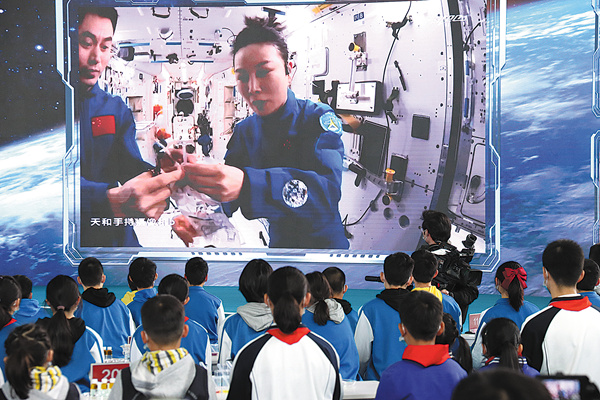

Educational feat
On June 11, 2013, a Long March 2F carrier rocket blasted off from the Jiuquan Satellite Launch Center in northwestern China's Gobi Desert and soon transported the Shenzhou X spacecraft to a low-Earth orbit at an altitude of about 400 kilometers to dock with the country's first experimental space station module-Tiangong I.
During their tight schedule on a 15-day flight, an important task for the Shenzhou X mission crew-Nie Haisheng, Zhang Xiaoguang and Wang Yaping-was to host the country's first educational activity from space.
Nine days later, Wang, the second Chinese woman to enter space, delivered a 45-minute science lecture along with her male colleagues.
Watched by more than 60 million Chinese students across the country, the open lesson made China the second nation, after the United States, to have delivered a lesson to schoolchildren from space. So far, only the two countries have accomplished this educational feat.
The idea of hosting science lectures from orbiting spacecraft began to be discussed among Chinese scientists in September 2011, right before the launch of Tiangong I.
Around the end of that year, the China Association for Science and Technology suggested that the China Manned Space Agency could carry out space-based science lessons for students during the joint flight of Tiangong I and Shenzhou IX or the Shenzhou X manned mission. The agency expressed strong interest in the idea and started feasibility study.
In November 2012, a detailed plan of the first space lecture was included in the Shenzhou X mission's flight schedule. Meanwhile, a work team was established with members from the space agency, science association and the Ministry of Education.
To make the lecture a success, more than 20 scientists, spacecraft designers, mission planners and veteran teachers were convened to offer their thoughts and advice. After rounds of brainstorming and discussions, they decided that the astronauts should conduct some experiments to show unique physical phenomena in space and that such experiments must serve educational purposes and must be easy for students to understand.
The experts designed specific plans for the experiments and produced tools to be used in the lecture. They also helped the mission crew practice and rehearse each step of the lesson. Their efforts paid off-the lecture was very popular among Chinese students and is regarded as one of the most memorable moments in the history of China's manned spaceflights.
For Zhang Zu'an, a university student in Shanghai who majors in law, watching the lecture at the age of 12, not only intrigued her about "magical physics in outer space", it also gave the then-schoolgirl a role model-Wang.
"I once dreamed of becoming an astronaut like Wang (Yaping) and I did think about joining the air force because all our astronauts were selected from air force pilots. However, my body conditions did not meet the required criteria," she said. "But I still followed Wang through her public speeches and media reports. I also read a lot about China's space programs."
Zhang said she has great respect and admiration for Wang and other Chinese astronauts and learned perseverance and diligence from them.
"They helped me know about the power of science and technology and showed me the capability and strength of our motherland. I am now a grown person, and it is my generation's turn to use our knowledge and skills to build the country into a better place," Zhang said.